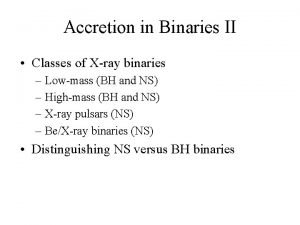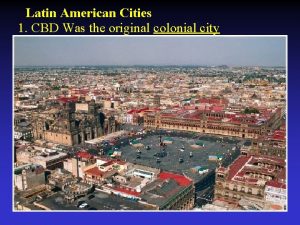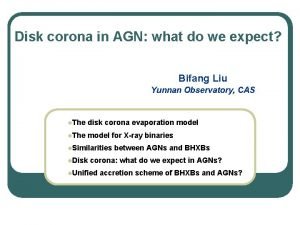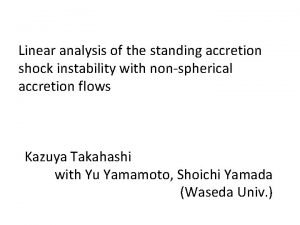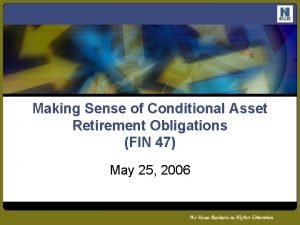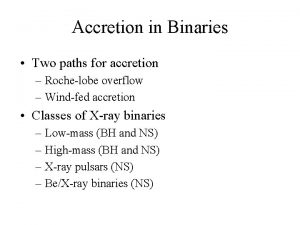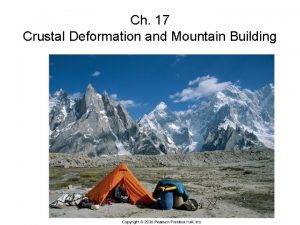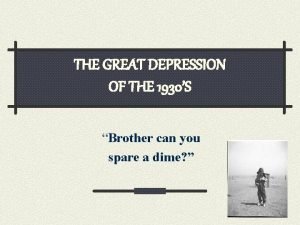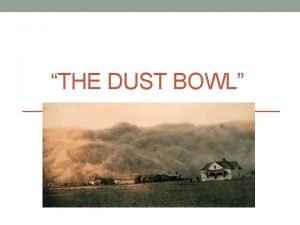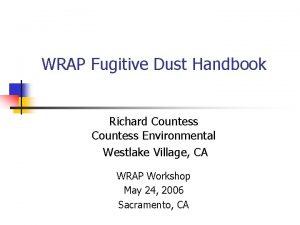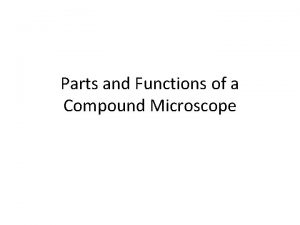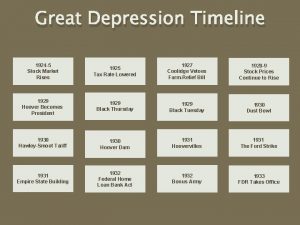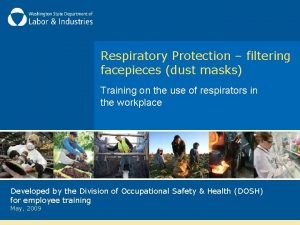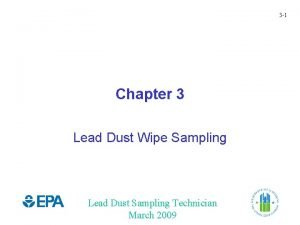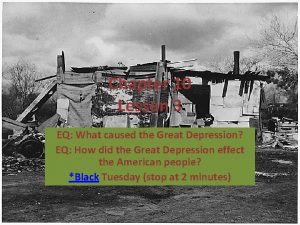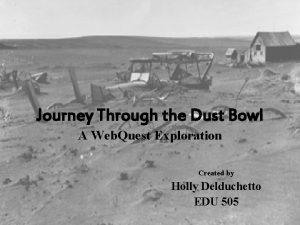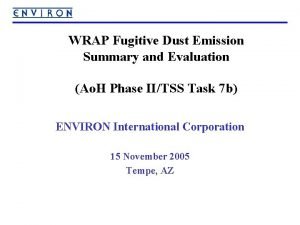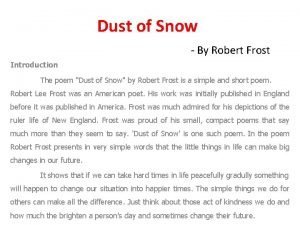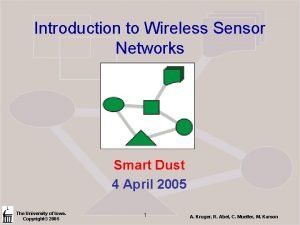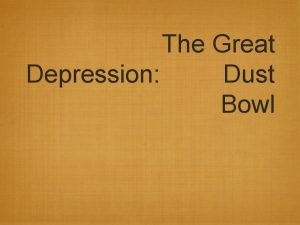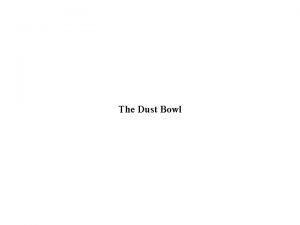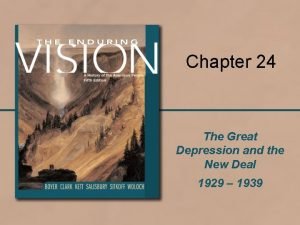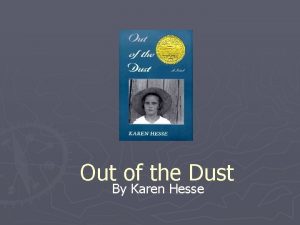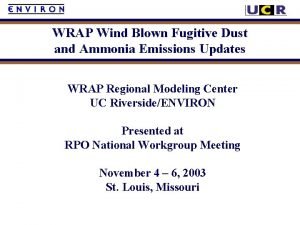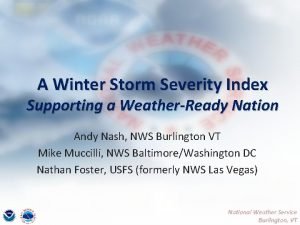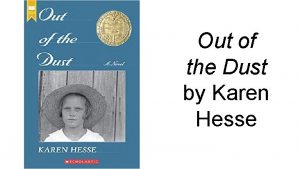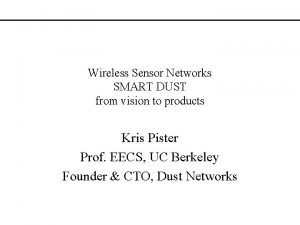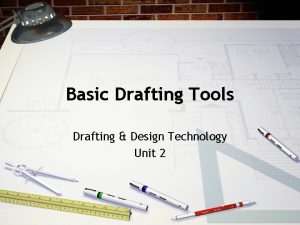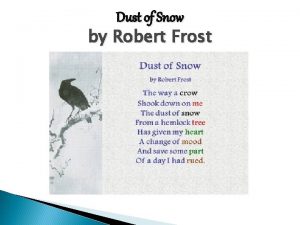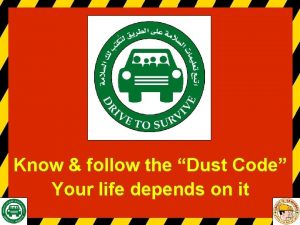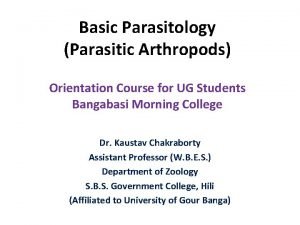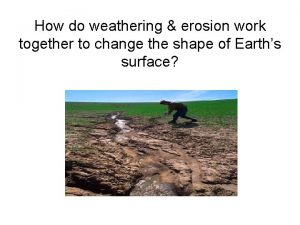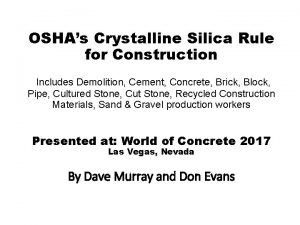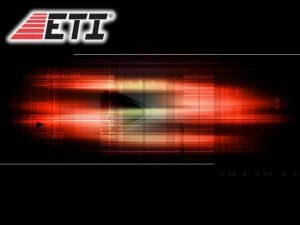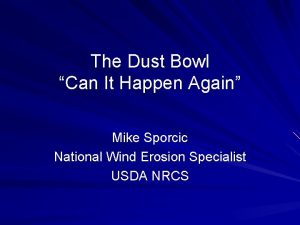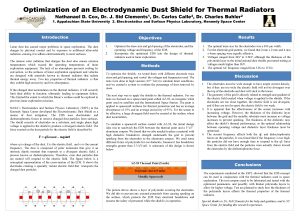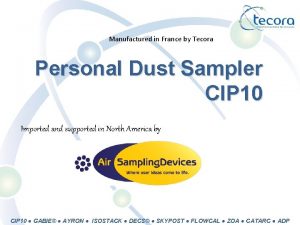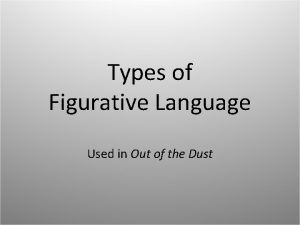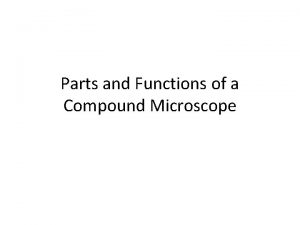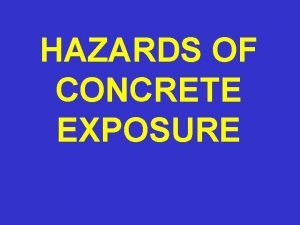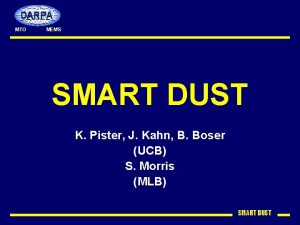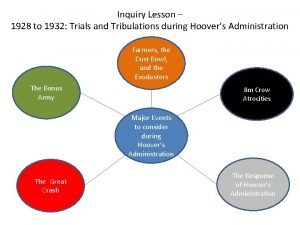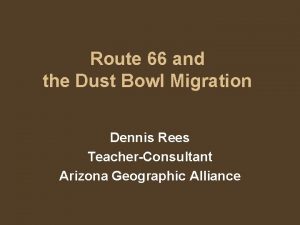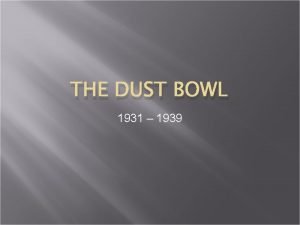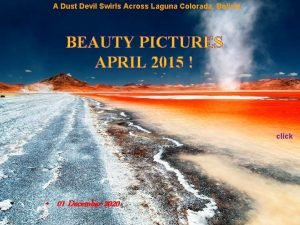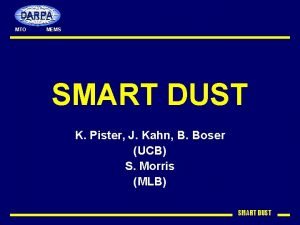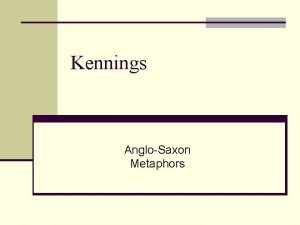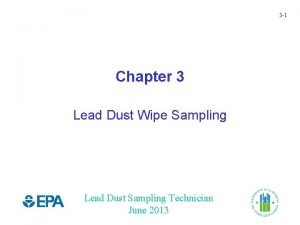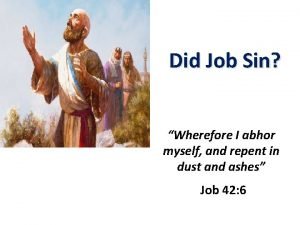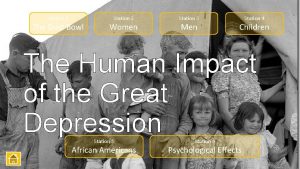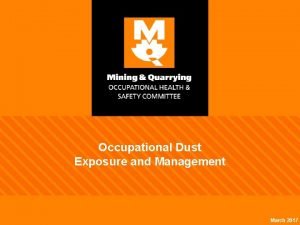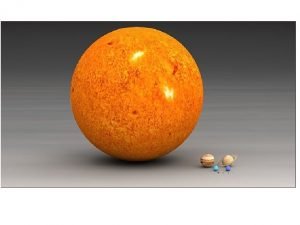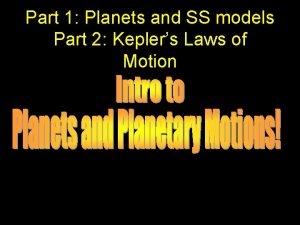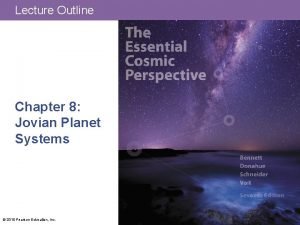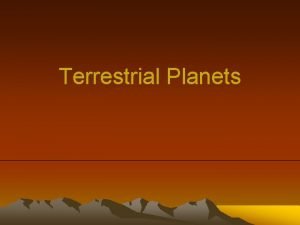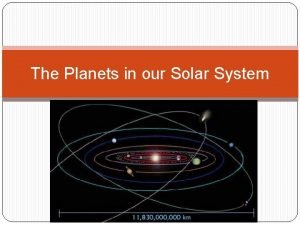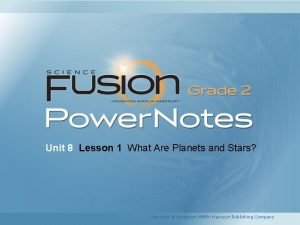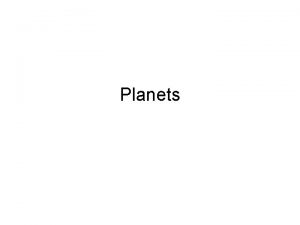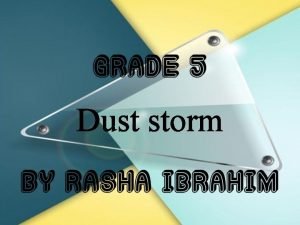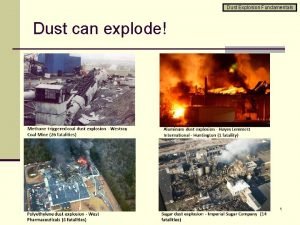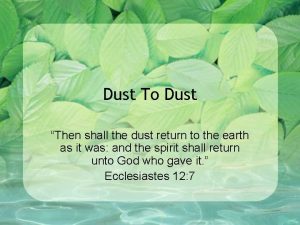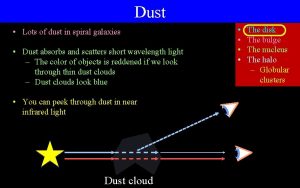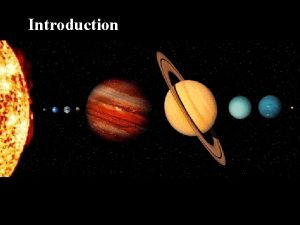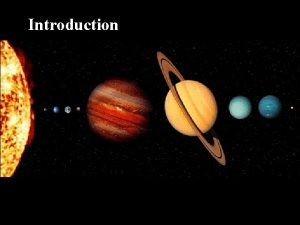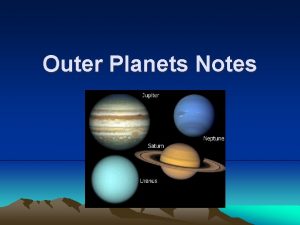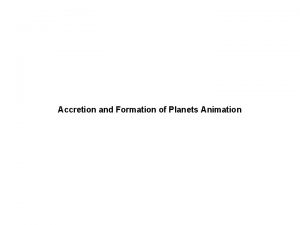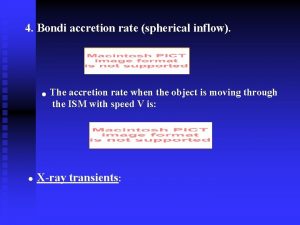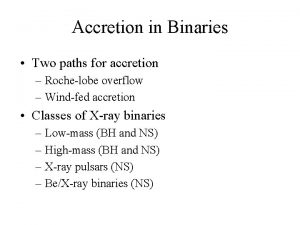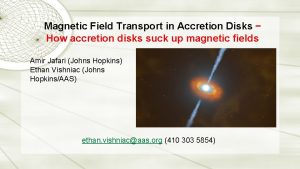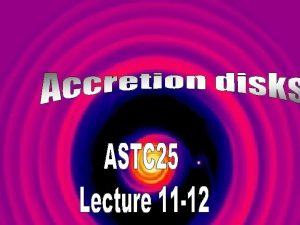Formation of Planets Accretion of dust in space





















































































- Slides: 85

Formation of Planets • Accretion of dust in space due to GRAVITATIONAL FORCES – Dust – Asteroids – Planets 1. accretion of Heavy elements 2. attraction of Light gases to dense nucleus

Origin Solar System

Formation of Planets • Recent planets were HOT – Compressional Heating – Impact Heating – Radioactive Decay • The Earth is layered by Densities – Densest Core – Lightest Crust


Earth’s Layers • Core (Fe, Ni) – – • Mantle (plastic) – – – • Inner Core (solid) Outer Core (liquid) very close to melting point Inner Mantle Asthenosphere Lithosphere (rigid) – – Upper Mantle (~100 km) (Lithosphere) Crust • • Oceanic Continental

Earth’s Core, Mantle and Crust

Ocean Floor and Margins

If the entire history of the earth were 1 year long: • Origin of Earth 4600 MY • Oceans first form 4000 MY • Oldest dated rocks 3800 MY • First life form 3600 MY • Ocean – Atmosphere equilibrium 1000 • Multicelular MY complex organisms 700 MY • Beginning of well known Geology 600 MY • First FISH! • First 510 Land. MY Plants 430 MY *

DECEMBER Dinosaurs evolve Dinosaurs extinct *

December 31 st • 9: 15 pm Homo sapiens evolves • Historical Times = 1 minute 18 sec. • Columbus discovers America = 3 sec. till midnight • HMS Challenger Expedition = 0. 9 sec. till midnight • You have been around for ~0. 13 seconds

Asthenosphere & Lithosphere

Crust • Oceanic Crust – – – Density: ~2. 9 g/m 3 Mineral composition: Basalt (Fe, Mg, Si. O 2) Thickness: ~5 -10 km Elevation: ~ 3800 m below sea level Age: <200 MY • Continental Crust – – – Density: ~2. 75 g/m 3 Mineral Composition: Granite (Na, K, Si. O 2) Thickness: ~20 -90 km Elevation: ~840 m above sea level Age: <3800 MY

Lithosphere

Study of Earth’s Interior • Rock Sampling & Drilling • Meteorites • Seismic Studies

Rock Drilling ODP (Ocean Drilling Program)

Meteorites http: //www. nmnh. si. edu/minsci/images/gallery/43. htm

Seismic Studies http: //pangea. stanford. edu/~sklemp/ http: //www. oceanmarine. com/


Seismic Studies • Differential speed of seismic/sound waves due to density differences – Pressure Waves (p) • Parallel to direction of motion • Travel through liquids – Shear Waves (s) • Perpendicular to direction of motion • DO NOT travel through liquids Seismic waves refract & reflect at density boundaries

Seismic Waves

Seismic Waves

Convection Processes Shallow and deep mantle convection cells

Convection Processes

Divergent Margins - Ridges • New oceanic crust formation • Spreading

Convergent Margins - Trenches • Oceanic crust Destruction • Convergence & Subduction

Lithosphere Plates

Earthquakes Shallow (0 -70 km) Medium (70 -300 km) Deep (>300 km)

250 – 225 MY

Spreading Cycles

Hot Spot


Hot Spot

Loihi Volcano


Evolution of Coral Reefs Fringe reefs Barrier reefs Atolls


Hot Spot Map

Convergent Margins • Continental Convergent Margins – Oceanic crust / Continental crust – Pacific Coast South America • Oceanic Convergent Margins – Oceanic crust / Oceanic crust – Aleutian Trench, Caribbean Arch • Continental Collision Margins – Continental crust / Continental crust – Himalaya mountains

Continental Convergent Margins Oceanic Convergent Margins Continental Collision Margins

Continental Convergent Margins Andes Mountains

Oceanic Convergent Margins Caribbean Island Arch

Convergent margin vulcanism St Helens

Convergent margin vulcanism http: //www. rsiphotos. com http: //www. montserratreporter. org/ Soufriere - Montserrat

Continental Collision Margin Himalaya Mountains



Divergent Margins • Oceanic Divergent Margins – – Two spreading plates, upwelling magma Central Rift Valley and Oceanic Ridge Mid Atlantic Ridge (Slow 1 -5 cm/year) East Pacific Rise (Fast 9 -18 cm/year) • Continental Divergent Margins – Crustal upwarp, Rift Valley, Linear Ocean – East African Ridge, Red Sea


Continental Divergent Margins African Rift Valley


Mid Atlantic Ridge http: //www. ngdc. noaa. gov/

Mid Atlantic Ridge http: //faculty. washington. edu/lyn 4/images/iceland. jpg

Mid Atlantic Ridge http: //www. geomorph. org/gal/mslattery/IAG 1. jpg

East Pacific Rise http: //www. ngdc. noaa. gov/

East Pacific Rise http: //geologyindy. byu. edu/

East Pacific Rise

Divergent margin vulcanism

Divergent margin vulcanism

Ocean Crust Age

Convection Processes Shallow and deep mantle convection cells

Passive Continental Margins

Figure 2. 28


Transform Faults • Two plates slide by each other • Numerous earthquakes along faults • Common in divergent and convergent margins

Transform Fault


Mid Atlantic Ridge http: //www. ngdc. noaa. gov/


San Andreas Fault between Pacific & N. American plates • http: //quake. wr. usgs. gov/kap/carrizo/




Plate Tectonics History • Alfred Wegener (1915) – Continental Drift Theory – Panagea (200 -250 MY)

Plate Tectonics History • Alfred Hess (1960) – Seafloor spreading theory – Geo-Poetry WHAT DATA PROVES PLATE TECTONICS?

Figure 2. 17

Magnetic Anomaly

Reversal Earth’s Magnetic Polarity

Sediment Thickness

Ocean Sediment Drilling ODP (Ocean Drilling Program)

Age Difference Ocean Crust: <200 MY Continental Crust: <3800 MY

Earth Quake Distribution

Earthquakes Shallow (<100 km) Deep (>100 km)

Continent Fitting

Paleomagnetism

Direct Movement Measurements
 What are the four outer planets called
What are the four outer planets called Are jovian planets more dense than terrestrial
Are jovian planets more dense than terrestrial What separates inner and outer planets
What separates inner and outer planets What is each planet made of
What is each planet made of Inner planets and outer planets
Inner planets and outer planets Accretion
Accretion Zone of in situ accretion
Zone of in situ accretion Accretion disk corona
Accretion disk corona Griffin-ford latin american model
Griffin-ford latin american model Standing accretion shock instability
Standing accretion shock instability Fin 47
Fin 47 Accretion
Accretion Orogenesis
Orogenesis Formation initiale vs formation continue
Formation initiale vs formation continue Camera space to world space
Camera space to world space Unscented trajectory chapter 5
Unscented trajectory chapter 5 Ndc to screen space
Ndc to screen space Space junk the space age began
Space junk the space age began Joint space vs cartesian space
Joint space vs cartesian space Dust bowl map activity
Dust bowl map activity Pictures of the dust bowl
Pictures of the dust bowl Wrap fugitive dust handbook
Wrap fugitive dust handbook Edmund crampin
Edmund crampin Simple microscope parts and functions
Simple microscope parts and functions Timeline of the great depression
Timeline of the great depression Combustible dust examples
Combustible dust examples Dust mask training
Dust mask training Lattice degeneration
Lattice degeneration Lead dust sampling wipes
Lead dust sampling wipes The great depression acrostic poem
The great depression acrostic poem From dust you came
From dust you came Dust bowl webquest
Dust bowl webquest Wrap fugitive dust handbook
Wrap fugitive dust handbook What does dust of snow
What does dust of snow Cotton poison
Cotton poison Smartdust
Smartdust Dust bowl
Dust bowl Arthur rothstein fleeing a dust storm
Arthur rothstein fleeing a dust storm War photographer duffy
War photographer duffy Dust bowl map
Dust bowl map Out of the dust characters
Out of the dust characters Dust bowl map
Dust bowl map Wrap fugitive dust handbook
Wrap fugitive dust handbook Storm severity index
Storm severity index Reaver wps
Reaver wps Out of the dust summary
Out of the dust summary Smart dust
Smart dust Used to lay out any noncircular curve
Used to lay out any noncircular curve Chalkdustdiva
Chalkdustdiva Dust bowl pictures woman
Dust bowl pictures woman When was dust of snow written
When was dust of snow written The dust code
The dust code Dust osvita
Dust osvita Dust bowl migration map
Dust bowl migration map Pictures of the dust bowl
Pictures of the dust bowl Diseases caused by dust
Diseases caused by dust Dust bowl 1930s
Dust bowl 1930s American cancer society
American cancer society Sternvent dust collector
Sternvent dust collector Entech dust collector
Entech dust collector Can the dust bowl happen again
Can the dust bowl happen again Electrodynamic dust shield
Electrodynamic dust shield Personal dust sampler
Personal dust sampler Onomatopoeia in out of the dust
Onomatopoeia in out of the dust Inclination joint microscope function
Inclination joint microscope function Shadows and dust meaning
Shadows and dust meaning Cement hazards
Cement hazards Smart dust darpa
Smart dust darpa Dust bowl
Dust bowl Route 66 dust bowl
Route 66 dust bowl Where did the dust bowl happen
Where did the dust bowl happen Dust devil bolivia
Dust devil bolivia Smart dust darpa
Smart dust darpa Prepositional kennings
Prepositional kennings Lead dust wipe sampling template
Lead dust wipe sampling template Abhor sin
Abhor sin Dust bowl woman
Dust bowl woman Silica dust exposure
Silica dust exposure Dust bowl slideshow
Dust bowl slideshow Holst the planets lesson plan
Holst the planets lesson plan Today planetary position
Today planetary position Esrt planets
Esrt planets Why do jovian planets have rings
Why do jovian planets have rings Smallest terrestrial planet
Smallest terrestrial planet How to remember the planets
How to remember the planets Planets. lesson 1
Planets. lesson 1





